Home Tags Posts tagged with "south korea"
south korea
South Korea is accusing North Korean spies of masterminding a series of high-profile cyber-attacks on its banks and television broadcasters in March.
Tens of thousands of computers were made to malfunction, disrupting work at banks and televisions in South Korea.
Investigators in Seoul said they had discovered some of the code involved was identical to that used in malware previously linked to Pyongyang.
The allegation adds to growing tension on the Korean peninsula.
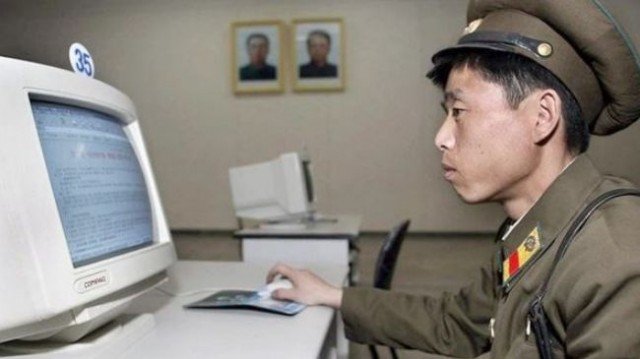
South Korea is accusing North Korean spies of masterminding a series of high-profile cyber-attacks on its banks and television broadcasters in March
On Tuesday North Korea told foreigners in the South to “work out measures for evacuation” to avoid becoming involved in a “thermonuclear war”.
Seoul’s foreign minister subsequently said that there was a “considerably high” risk that North Korea might fire a ballistic missile at it over the coming days.
North Korea has not commented on the cyber-attack accusation.
About 48,000 PCs and servers in South Korea were struck on March 20.
The assault shut down computer networks at TV stations KBS, MBC and YTN, and halted operations at three banks – Shinhan, NongHyup and Jeju.
Investigators in Seoul reported their initial findings suggested North Korea’s military-run Reconnaissance General Bureau had been responsible.
A spokesman announced that 30 out of 76 programs recovered from affected computers were the same as those used in previous strikes.
In addition he said that 22 of the 49 internet protocol (IP) addresses involved in the incidents matched those used in attacks blamed on North Korea over the past five years.
The recent assaults shortly followed a South Korea-US joint military exercise, but it was suggested they had been long in the planning.
“The attackers gained control of personal computers or server computers within the target organizations at least eight months ago,” a government statement reported in the Korea Herald said.
“After maintaining monitoring activities [they] sent out the command to delete data stored in the server, and distributed malware to individual computers through the central server.”
South Korea’s Financial Services Commission added that no bank records or personal data had been compromised.
Previous cyber-intrusions blamed on Pyongyang include attempts to block access to the website of South Korea’s presidential office and other government departments, and hacks of computers at Nonghyup bank and the Joonang Ilbo newspaper.
In turn, North Korea has accused both South Korea and the US of preventing users from being able to visit its official media sites – the Rodong Sinmun newspaper and the Korean Central News Agency (KCNA) – earlier this year.
It has led some commentators in the South to criticize the state of their cyber-defenses bearing in mind the public there is much more reliant on the internet than citizens in North Korea.
“South Korea cannot cope with unpredictable and sophisticated provocations from North Korea with a bureaucratic, rigid mindset,” wrote Chae In-taek in the Joonang Ilbo.
“National security cannot be assured through an outdated system. We must come up with an innovative security system fast.”
[youtube YWjf9ppjDoQ]
South Korea has decided to raise its alert level to “vital threat” following reports that North Korea is preparing for a missile test.
At least one ballistic missile with an estimated 2,000-mile (3,000 km) range is fuelled and ready for launch, US and South Korean sources say.
Pyongyang has been making bellicose threats against South Korea, Japan and US bases in the region.
The threats follow tough new UN sanctions imposed on North Korea last month following its third nuclear test in February this year.
Separately, an initial investigation by South Korea into a major cyber attack last month that affected a number of banks and broadcasters has said North Korea is to blame.

affected a number of banks and broadcasters has said the North is to blame.
North Korea is believed to have completed preparations for a missile launch after it moved two Musudan missiles to its east coast, Yonhap news agency says.
In anticipation, the South Korea-US Combined Forces have raised their alert level to Watchcon 2 (Vital threat), to increase surveillance monitoring, Yonhap quoted a senior military official as saying.
North Korea unveiled the Musudan missile during a military parade in 2010 but has yet to test it. There are reports, however, that it may have been sold to Iran and tested there.
The launch could happen “anytime from now”, South Korean Foreign Minister Yun Byung-se told parliament.
A test launch would be a violation of UN Security Council Resolution 1718, passed in 2006, which states the North “must not conduct any further nuclear test or launch of a ballistic missile”.
North Korea has tested intermediate range missiles before and during periods of crisis and tension.
While another test launch would certainly be seen as provocative, it is unlikely to have any major, short-term military significance unless it goes wrong.
The raising of South Korea’s alert status comes as Japan deployed anti-missile defenses in Tokyo as a precaution.
“We are on high alert,” said Japan’s Defence Minister Itsunori Onodera.
A number of travel agencies in China have reported that tourist trips into North Korea have been suspended.
One travel agent in the north-eastern city of Dandong told Reuters news agency: “All [tourist] travel to North Korea has been stopped from today and I’ve no idea when it will restart.”
The border remains open to commercial traffic.
Meanwhile, an official investigation by South Korea into last month’s cyber attack traced the malicious codes used to six computers in North Korea.
“We’ve collected a lot of evidence to determine the North’s Reconnaissance General Bureau led the attack, which had been prepared for at least eight months,” a spokesman for the Korea Internet and Security Agency said.
The attack on March 20 severely affected the KBS, MBC and YTN broadcasters and operations at the Shinhan, NongHyup and Jeju banks.
Yesterday North Korea has warned foreigners in South Korea to take precautions in case of war and UN Secretary-General Ban Ki-moon warned the crisis on the Korean peninsula may become “uncontrollable”.
Ban Ki-moon once again urged North Korea to tone down its “provocative rhetoric” and to keep open a joint North-South Korean industrial complex.
North Koreans failed to report for work at the Kaesong complex on Tuesday, suspending one of the few points of co-operation with South Korea.
Watchcon status:
- Level Four – Used during peacetime
- Level Three – Important threat
- Level Two – Vital threat
- Level One – Used during wartime
[youtube D8oNZFA_zkY]
A statement attributed to North Korea’s Asia-Pacific Peace Committee on Tuesday warned the situation on the Korean peninsula is heading for a nuclear war.
The statement said: “The situation on the Korean peninsula is heading for a thermo-nuclear war.
“In the event of war, we don’t want foreigners living in South Korea to get hurt.”
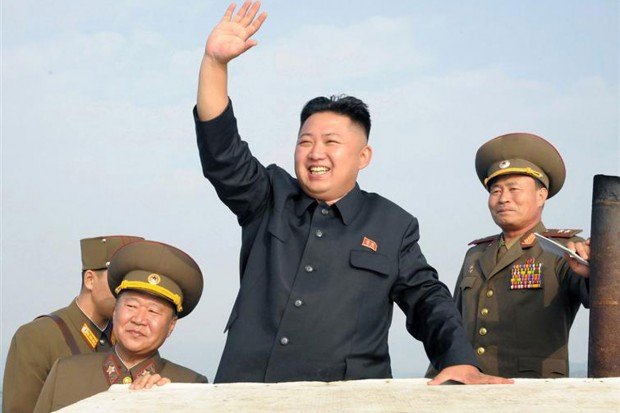
A statement attributed to North Korea’s Asia-Pacific Peace Committee on Tuesday warned the situation on the Korean peninsula is heading for a nuclear war
North Korea’s statement urged “all foreign organizations, companies and tourists to work out measures for evacuation”.
Last Friday, Pyongyang warned it would not be able to guarantee the safety of embassy staff in the event of a war.
No foreign embassies immediately announced plans to evacuate, and the UK and Russian embassies have said they have no plans to shut their embassies.
The US, which has also been threatened by Pyongyang, has said there were no imminent signs of threats to American citizens.
Tuesday’s warning from Pyongyang to foreigners in South Korea came amid growing concern that North Korea may be about to launch a missile test.
Japan has deployed defensive anti-missile batteries at three locations in Tokyo, to protect the capital’s 30 million residents.
US-made Patriot anti-missile systems have been deployed at the defense ministry and at two other military bases.
[youtube VxyLpbeJ7Zg]
North Koreans workers have failed to report for work at Kaesong Industrial Complex, suspending one of the few points of co-operation between the two Koreas.
Kaesong Industrial Complex is a joint industrial park and there are more than 120 South Korean companies that operate there, employing 53,000 North Korean workers.
The complex is seen as a crucial source of hard currency for North Korea.
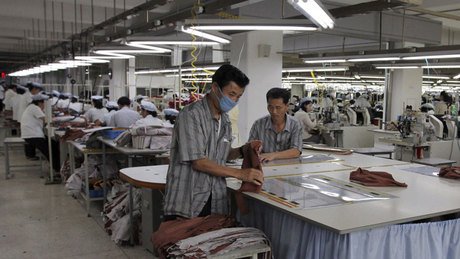
North Koreans workers have failed to report for work at Kaesong Industrial Complex
The move is the latest in a series of provocations that have raised tensions in the Korean peninsula and the region.
“As of now, no North Korean workers have reported to work this morning,” a spokesperson for the South Korean Unification Ministry said.
The ministry added that 77 South Korean workers would leave the zone on Tuesday, but 479 were still inside Kaesong.
Kaesong complex was launched in 2003 and was largely funded by South Korea.
Seoul has said the purpose of the complex was to develop a joint industrial park where South Korean companies could manufacture their products using North Korean labor.
It said that would help North Korea start to reform its economy, which is in a dire state, and ease tensions between the two Koreas.
South Korea has given incentives to companies to try and encourage them to set up operations there. These include political risk insurance to cover losses in their investment.
As a result, if the project is threatened, South Korea also tends to lose.
South Korean President Park Geun-hye said the boycott by North Korea would harm the country’s credibility.
“Investment is all about being able to anticipate results and trust and when you have the North breaking international regulations and promises like this and suspending Kaesong while the world is watching, no country in the world will invest in the North,” she told a cabinet meeting in Seoul.
“I don’t know what to do, honestly. I can’t simply tell my workers to leave or stay,” an executive from a South Korean clothing firm told the Reuters news agency.
“North Korean workers didn’t talk a lot, but they appeared to have complaints about Kaesong being closed,” the agency also quoted South Korean worker Sing Dong-chul as saying.
“They worried whether they would be working or not.”
Seen as a litmus test of relations on the Korean peninsula, Kaesong also provides hard currency for North Korea through taxes and workers’ wages.
South Korean companies pay more than $80 million a year in salaries. As a whole, the Kaesong complex produced $470 million worth of goods in 2012.
It accounts for nearly all inter-Korean trade.
For almost a decade the joint industrial zone has chugged on, through North Korean nuclear tests, rhetoric, and even military clashes with the South.
But now the last symbol of joint inter-Korean co-operation is effectively suspended.
North Korea has blocked access to South Koreans working there since Wednesday.
On Monday it said it would withdraw all its own employees and suspend operations in the zone. A decision would come later on whether it would shut it down for good.
North Korea has expressed anger at South Korean media reports that the North would not shut down Kaesong because its struggling economy is heavily dependent on the complex.
[youtube fvCn975iSeI]
In a new rhetoric, North Korea has warned foreign companies and tourists in South Korea to take evacuation measures in case of war.
This comes amid growing concern that North Korea may be about to launch its fourth missile test.
Pyongyang has been making bellicose threats against South Korea, Japan and US bases in the region.
Japan has deployed defensive anti-missile batteries at three locations in Tokyo, to protect the capital’s 30 million residents.
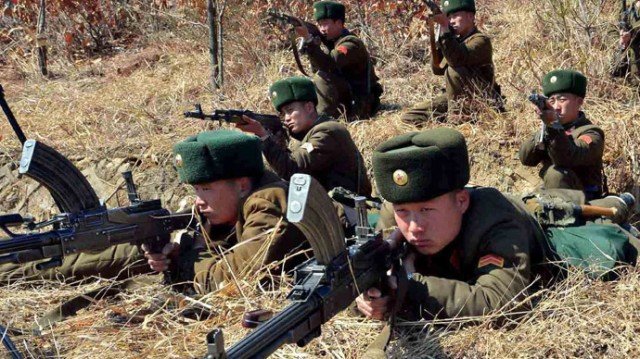
North Korea has warned foreign companies and tourists in South Korea to take evacuation measures in case of war
US-made Patriot anti-missile systems have been deployed at the defense ministry and at two other military bases.
“The government is making utmost efforts to protect our people’s lives and ensure their safety,” Prime Minister Shinzo Abe said.
“As North Korea keeps making provocative comments, Japan, co-operating with relevant countries, will do what we have to do,” he added.
At the end of last week Japan sent two of its most modern warships to the Sea of Japan with orders to shoot down any missiles fired by North Korea towards the Japanese islands.
Intelligence reports also suggest North Korea has moved two intermediate range missiles to its east coast in recent days.
Reports say no-one in Japan thinks Pyongyang is really preparing to attack.
But it may try to fire a missile over the top of Japan in to the Pacific Ocean. If it does Tokyo has made it clear it will shoot the missile down.
This is not the first time that Japan has taken such measures.
A statement attributed to Pyongyang’s Asia-Pacific Peace Committee said on Tuesday: “The situation on the Korean peninsula is heading for a thermo-nuclear war.
“In the event of war, we don’t want foreigners living in South Korea to get hurt.”
The statement urged “all foreign organizations, companies and tourists to work out measures for evacuation”.
Last Friday, Pyongyang warned it would not be able to guarantee the safety of embassy staff in the event of a war.
No foreign embassies immediately announced plans to evacuate, and the UK and Russian embassies have said they have no immediate plans to shut their embassies.
The US, which has also been threatened by North Korea, has said there were no imminent signs of threats to American citizens.
The UK Foreign and Commonwealth advice on travel to South Korea was that there was “no immediate increased risk or danger to those living in or travelling to South Korea” as a result of the North Korean warning last Friday.
Tuesday’s warning to foreigners in South Korea is the latest step in the escalation of tension on the Korean peninsula.
North Korean employees on Tuesday did not report for work at the Kaesong Industrial Complex, suspending one of the few points of co-operation between North and South Korea.
The UN imposed tough sanctions on North Korea last month following its third nuclear test.
Pyongyang has responded to this and to joint military exercises between South Korea and the US with escalating rhetoric. It has threatened to use nuclear weapons and said it would restart a nuclear reactor.
North Korea has also shut down an emergency military hotline between Seoul and Pyongyang.
[youtube XW2pnl9Djlc]
North Korea has announced today it is withdrawing all its workers from the joint-Korean Kaesong industrial zone and suspending operations there.
The move follows weeks of warlike rhetoric from Pyongyang after it was sanctioned by the UN for carrying out its third nuclear test in February.
Kaesong industrial park was established almost a decade ago and had been a symbol of co-operation between North and South Korea.
However, a North Korean official said it could now be closed permanently.
In a statement, South Korea’s Unification Ministry said the decision “cannot be justified in any way and North Korea will be held responsible for all the consequences,” the AFP news agency reports.
Kaesong complex, just over the border in North Korea, employs more than 50,000 North Korean workers but is funded and managed by South Korean firms.

North Korea has announced today it is withdrawing all its workers from the joint-Korean Kaesong industrial zone and suspending operations there
Pyongyang has already banned South Koreans from entering, but during a visit to the site, Kim Yang-gon, secretary of the party’s Central Committee, said North Korea would now “temporarily suspend the operations in the zone and examine the issue of whether it will allow its existence or close it”.
The North’s KCNA news agency quoted Kim Yang-gon as saying that South Korea and the US “insult the country’s dignity and make the zone a starting point of war”.
“How the situation will develop in the days ahead will entirely depend on the attitude of the South Korean authorities,” Kim Yang-gon said.
The statement made no reference to the nearly 500 South Koreans who are in Kaesong as managers.
One South Korean told the Associated Press he had heard nothing about the order from the North Korean government.
“North Korean workers left work at six o’clock today as they usually do. We’ll know tomorrow whether they will come to work,” he said.
Earlier, South Korean officials played down reports that the North could be about to carry out a nuclear test.
A defense ministry spokesman said the widely reported activity detected at the Punggye-ri underground test site appeared to be routine and that there was “no indication that a nuclear test is imminent”.
UN Secretary General Ban Ki-moon said such a nuclear test would be a “provocative measure”, and warned that North Korea cannot continue “confronting and challenging the authority of the Security Council and directly challenging the whole international community”.
Russia and China have called for calm and a return to dialogue.
Speaking during a visit to Germany, Russian President Vladimir Putin said that as a neighbor of North Korea his country was “worried about the escalation” of tensions.
Vladimir Putin warned there was a risk of a conflict on the Korean peninsula which would make the Chernobyl nuclear disaster “seem like a child’s fairy tale”.
The UN imposed tough sanctions on North Korea following its third nuclear test on February 12.
Pyongyang has responded by issuing almost daily threats to use nuclear weapons and saying it would restart its nuclear reactor.
North Korea has also shut down an emergency military hotline between Seoul and Pyongyang.
Last week it warned it would not be able to guarantee the safety of foreign embassy staff after April 10, and that countries should begin evacuating their diplomatic staff.
North Korea’s state media have been broadcasting a continuing diet of war and retribution with programmes about biochemical war, nuclear war and military preparations dominating the listing.
However, some analysts have suggested that the rhetoric is in large part designed to shore up the standing of a young, inexperienced leader, Kim Jong-un.
Meanwhile, Japan’s defence ministry said the country’s armed forces have been ordered to shoot down any North Korean missile headed towards its territory.
Over the weekend, the US cancelled a scheduled test of its Minuteman III ballistic missile, citing concerns that it could be misinterpreted by Pyongyang.
[youtube hGktEoEDLyI]
North Korea appears to be preparing for a fourth nuclear test, according to South Korean officials.
South Korean Unification Minister Ryoo Kihl-jae told lawmakers there were signs of increased activity in North Korea’s main nuclear test site.
North Korea has stepped up its habitual fiery rhetoric against the US and South Korea in recent weeks.
Correspondents say it is unclear whether a test is being prepared or it is a ruse to boost the sense of crisis.
Ryoo Kihl-jae did not elaborate on the specific intelligence which led South Korea to suspect the North was set to carry out its fourth nuclear test.

North Korea appears to be preparing for a fourth nuclear test, according to South Korean officials
But when asked about a news report that North Korea had stepped up activity at the underground site it has used in previous tests, he said “there are such signs”.
Kim Min-seok, a spokesman for South Korea’s defense ministry, said it was possible that the North could fire a ballistic missile and conduct a nuclear test at the same time.
But South Korean official Yonhap news agency quoted him as playing down the threat of an imminent test, saying there were several facilities at the nuclear test site so the movement of vehicles and people there was expected.
“Currently, there is no new movement to add on to the previous briefing,” he said.
Newspaper JoongAng Ilbo quoted an unnamed South Korean official as saying that South Korean intelligence had detected “increased activity of labor forces and vehicles” at the Punggye-ri nuclear test site in the country’s north-east.
“We are closely monitoring the ongoing situation, which is very similar to the situation ahead of the third nuclear test,” the official told the newspaper.
“We are trying to figure out whether it is a genuine preparation for a nuclear test or just a ploy to heap more pressure on us and the US.”
The UN imposed tough sanctions on North Korea last month following its third nuclear test. Pyongyang responded by stepping up angry rhetoric, including threats to use nuclear weapons and restarting its nuclear reactor.
In recent weeks, North Korea has shut down an emergency military hotline between Seoul and Pyongyang, stopped South Koreans from working at the Kaesong joint industrial complex and warned it would not be able to guarantee the safety of foreign embassy staff in the event of a war.
On Monday, the North Korea’s state news agency said a senior official had visited the Kaesong complex and told workers there to prepare for all possible developments.
Analysts have suggested that the rhetoric is in large part designed to shore up the standing of a young, inexperienced leader, Kim Jong-un, in the eyes of his own people.
North Korea’s state media have been broadcasting a continuing diet of war and retribution with programmes about biochemical war, nuclear war and military preparations dominating the listing.
Meanwhile, Japan’s defense ministry said the country’s armed forces have been ordered to shoot down any North Korean missile headed towards its territory.
Over the weekend, the US cancelled a scheduled test of its Minuteman III ballistic missile, citing concerns that it could be misinterpreted by Pyongyang.
[youtube _8y-WNFREQc]
North Korea released a bizarre video of military dogs attacking an effigy of South Korean defense minister Kim Kwan-Jin and again threatened to attack their South neighbors.
The new propaganda clip was shown on state television on Sunday.
The animals can also be seen jumping through a flaming hole as they are put through their paces in training.

North Korea released a bizarre video of military dogs attacking an effigy of South Korean defense minister Kim Kwan-Jin and again threatened to attack their South neighbors
The new video was released as the US delayed an intercontinental ballistic missile test planned for next week amid fears it will be misinterpreted by Pyongyang.
In the same video troops can also be seen using the South Korean defense minister’s face as target practice.
At the very end of the clip the effigy is destroyed with a rocket launcher.
It is unclear when and where the video, released by North Korea’s official news agency KCNA, was filmed.
An unidentified North Korean soldier warns that they are ready to attack South Korea as soon as the order is given.
“On the Korean peninsula, it is not a matter of whether we will have a war or not but whether it will take place today or tomorrow,” he said.
“This is a situation like being on the eve of a big explosion. Every minute, every second counts. We are right now set to march, once the order is given.”
The claim follows weeks of ever-increasing threats from North Korea which claims to have missiles capable of hitting the US.
[youtube _9jNIUtUn3c]
South Korea has decided to deploy two warships with missile-defense systems, one day after North Korea apparently moved a missile to its east coast.
Military officials told South Korean media the two warships would be deployed on east and west coasts.
Seoul has sought to play down North Korea’s latest move, saying they may be preparing for a missile test.

South Korea has decided to deploy two warships with missile-defense systems, one day after North Korea apparently moved a missile to its east coast
In recent weeks, North Korea has ramped up its rhetoric and made specific threats to target US territory.
One of the targets named by Pyongyang was the Pacific island of Guam, which hosts a US military base.
On Thursday, the US confirmed it would deploy a missile-defense system to Guam in response to the threats.
“The moves that we have been making are designed to ensure and to reassure the American people and our allies that we can defend the United States,” said US State Department spokeswoman Victoria Nuland.
[youtube un3ILKFueb0]
North Korea has shifted a missile with “considerable range” to its east coast, South Korea’s Foreign Minister Kim Kwan-jin has announced.
Kim Kwan-jin played down concerns that the missile could target the US mainland, and said North Korea’s intentions were not yet clear.
Pyongyang earlier renewed threats of a nuclear strike against the US, though its missiles are not believed to be capable of carrying nuclear warheads.
The US is responding to North Korea by moving missile defense shields to Guam.
Meanwhile, Russia said Pyongyang’s attempts to “violate decisions of the UN Security Council are categorically unacceptable”.
“This radically complicates, if it doesn’t in practice shut off, the prospects for resuming six-party talks,” foreign ministry spokesman Alexander Lukashevich said in a statement on Thursday.
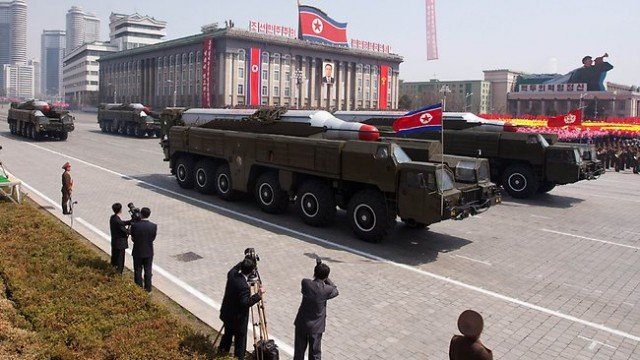
North Korea has shifted a missile with “considerable range” to its east coast
The talks involving North and South Korea, the US, Russia, China and Japan were last held in late 2008.
Japan said it was co-operating closely with the US and South Korea to monitor North Korea’s next move.
Japan’s PM Shinzo Abe said that although the rhetoric was “increasingly provocative”, Tokyo would “calmly” watch the situation.
Government spokesman Yoshihide Suga earlier told reporters that Japan was braced for a “worst-case scenario”.
The Pentagon said the shield on its Pacific island territory would be ready within weeks, adding to warships already sent to the area.
North Korea has previously named Guam among a list of possible targets for attack that included Hawaii and the US mainland.
Japanese and South Korean reports had suggested the missile being moved by North Korea was a long-range one with a capability of hitting the US west coast.
However, experts believe North Korea’s most powerful rocket, which it test-fired last December, has a range of 3,700 miles (6,000 km) and can reach no further than Alaska.
Kim Kwan-jin told MPs in a parliamentary defense committee meeting that the missile had “considerable range”.
“The missile does not seem to be aimed at the US mainland. It could be aimed at test firing or military drills,” he said.
Analysts have interpreted Kim Kwan-jin’s description as referring to the Musudan missile, estimated to have a range up to 2,500 miles (4,000 km). Guam would be within that range.
North Korea is believed to have its main military research centres in the east.
It has test-fired missiles from there before, and its three nuclear weapons tests were carried out in the east.
Despite its belligerent rhetoric, North Korea has not taken direct military action since 2010, when it shelled a South Korean island and killed four people.
In recent weeks North Korea has threatened nuclear strikes and attacks on specific targets in the US and South Korea.
The communist country has announced a formal declaration of war on the South, and pledged to reopen a mothballed nuclear reactor in defiance of UN Security Council resolutions.
In its latest statement, attributed to a military spokesman, North Korea appeared to refer to continuing military exercises between the US and South Korea in which the US has flown nuclear-capable bombers over the South.
The statement said the “ever-escalating US hostile policy towards the DPRK [North Korea] and its reckless nuclear threat will be smashed”.
North Korea promised to use “cutting-edge smaller, lighter and diversified nuclear strike means of the DPRK” and said the “merciless operation of its revolutionary armed forces in this regard has been finally examined and ratified”.
The US Department of Defense said on Wednesday it would deploy the ballistic Terminal High Altitude Area Defense System (THAAD) to Guam in the coming weeks.
The THAAD system includes a truck-mounted launcher and interceptor missiles.
US officials recently also announced that the USS John McCain, a destroyer capable of intercepting missiles, had been positioned off the Korean peninsula.
Some analysts say Pyongyang’s angry statements are of more concern than usual because it is unclear exactly what North Korea hopes to achieve.
As well as the angry statements, North Korea has also shut down an emergency telephone line between Seoul and Pyongyang and stopped South Koreans from working at Kaesong Industrial Complex in the North.
Kaesong industrial park, one of the last remaining symbols of co-operation between the neighbors, is staffed mainly by North Koreans but funded and managed by South Korean firms.
[youtube ZuoB_8dkAzc]
North Korea has blocked the entry of South Korean workers into joint Kaesong industrial zone, in a move seen as further escalating tensions.
South Korean workers were being allowed to leave Kaesong Industrial Complex but not cross into it from the South, Seoul’s Unification Ministry confirmed.
The Kaesong zone at North-South border, which is a money-maker for North Korea, is seen as a key barometer of inter-Korean relations.

North Korea has blocked the entry of South Korean workers into joint Kaesong industrial zone
The move came as the US called North Korea’s recent rhetoric unacceptable.
Kaesong Industrial Complex is home to more than 100 factories. More than 50,000 North Koreans work there, as well as several hundred South Korean managers.
Permission is granted on a daily basis for workers to cross into the complex, where they can stay overnight. More than 850 South Koreans were at Kaesong when the ban was announced.
“South Korea’s government deeply regrets the entry ban and urges it be lifted immediately,” Unification Ministry spokesman Kim Hyung-seok told reporters.
“Ensuring the safety of our citizens is our top priority and the South Korean government will take necessary measures based on this principle,” he said.
The entry ban is not unprecedented – South Koreans were briefly denied access in March 2009 because of US-South Korea military exercises.
North Korea, which has been angered by UN sanctions imposed after its recent nuclear test and annual US-South Korea military drills, threatened to shut down the complex last week.
In recent weeks North Korea has also threatened attacks on US military bases in Asia and South Korean border islands.
On April 2, North Korea said it planned to restart its mothballed reactor at Yongbyon – the source of plutonium for its nuclear weapons programme.
Later in the day, US Secretary of State John Kerry called recent North Korean actions “dangerous” and “reckless”.
“Let me be perfectly clear here today. The United States will defend and protect ourselves and our treaty ally, the Republic of Korea (South Korea),” John Kerry said after talks with his South Korean counterpart Yun Byung-se.
In recent days the US has responded to North Korea with a series of high-profile flights of advanced aircraft, including stealth fighters and nuclear-capable B-52 bombers, over South Korea.
Officials have also confirmed that the USS John McCain, an Aegis-class destroyer capable of intercepting missiles, has been positioned off the Korean peninsula.
A second destroyer, the USS Decatur, has been sent to the region.
Earlier on Tuesday UN Secretary-General Ban Ki-moon had warned that the crisis had “gone too far” and called for urgent talks with the North.
“Things must begin to calm down, there is no need for the DPRK [North Korea] to be on a collision course with the international community. Nuclear threats are not a game,” Ban Ki-moon said.
[youtube wJKF59T62mA]
North Korea has announced it will restart the facilities at its main Yongbyon nuclear complex, including a reactor mothballed in 2007.
In a statement, it has been announced that the move would bolster North Korea’s nuclear forces “in quality and quantity”.

North Korea has announced it will restart the facilities at its main Yongbyon nuclear complex, including a reactor mothballed in 2007
The move is the latest in a series of measures by Pyongyang in the wake of its third nuclear test in February 12.
North Korea has been angered by the resultant UN sanctions and joint US-South Korea annual military drills.
In recent weeks North Korea has issued a series of threats against both South Korean and US targets, to which the US has responded with high-profile movements of advanced aircraft and warships around the Korean peninsula.
The reactor at Yongbyon – which was the source for plutonium for North Korea’s nuclear weapons programme – was closed in July 2007 as part of a disarmament-for-aid deal.
The cooling tower at the facility was later destroyed, but then the disarmament deal stalled.
Part of the reason the agreement fell apart was because the US and North Korea’s other negotiating partners did not believe Pyongyang was fully disclosing all of its nuclear facilities.
The statement, carried by KCNA news agency, was attributed to a spokesman for the General Department of Atomic Energy.
The General Department of Atomic Energy had decided “to adjust and alter the uses of the existing nuclear facilities” including “readjusting and restarting all the nuclear facilities in Nyongbyon [Yongbyon]”.
The work would be put into practice without delay, the statement said.
[youtube zsrxJwd-yZo]
South Korea has pledged a “strong response” to North Korea’s aggressions, amid high tensions on the peninsula.
Speaking to defence officials on Monday, President Park Geun-hye said that she took the series of threats from Pyongyang “very seriously”.
North Korea announced on Saturday that it was entering a “state of war” with South Korea.
On Sunday, the US sent stealth fighters to South Korea, as North Korea pledged to build up its nuclear arsenal.

South Korea has pledged a “strong response” to North Korea’s aggressions, amid high tensions on the peninsula
“If there is any provocation against South Korea and its people, there should be a strong response in initial combat without any political considerations,” President Park Geun-hye said.
In recent days North Korea has issued multiple warnings of attacks on US and South Korean targets – to which the US has responded with an apparent show of military hardware.
North Korea has been angered both by UN sanctions imposed after its nuclear test in February and the joint US-South Korea annual
The US flew F-22 planes from Japan to South Korea’s Osan Air base on Sunday, as part of ongoing joint military exercises with South Korea, officials said.
“[North Korea] will achieve nothing by threats or provocations, which will only further isolate North Korea and undermine international efforts to ensure peace and stability in Northeast Asia,” the US military command in South Korea said in a statement reported by Reuters news agency.
In March, the US deployed both B-2 and B-52 planes, which have nuclear capabilities, over South Korea. It said this demonstrated its “capability… to provide extended deterrence to [its] allies in the Asia-Pacific region”.
It is not the first time F-22s have been used drills with South Korea, but the move came as North Korea’s Central Committee held a rare high-level meeting on Sunday.
The committee described nuclear weapons as “the nation’s life” and vowed to further develop its nuclear programme, state-run news agency KCNA said.
“Only when the nuclear shield for self-defence is held fast, will it be possible to shatter the US imperialists’ ambition for annexing the Korean Peninsula by force,” the report added.
North Korea’s Supreme People’s Assembly – the rubber-stamp parliament – is also due to convene on Monday for a day-long annual session.
While the group normally focuses on making economic decisions, this meeting will be keenly watched given the current high tension.
Few think North Korea – which last week cut a military hotline which was the last official direct link with Seoul – would risk full-blown conflict.
But in recent years there have been deadly incidents such as the sinking of a South Korea warship (in which Pyongyang denies any role) and the shelling of a South Korean island.
However, the jointly-run Kaesong industrial park, which is located within North Korea’s borders, remains in operation.
Workers from South Korea were crossing into the park – which is a key money-maker for North Korea – as normal on Monday, reports said.
Kaesong Industrial Complex is seen as a barometer of North-South tensions, observers say, and a move to close it would be seen as an escalation of current tensions.
[youtube e9Z3LTl66CE]
North Korea has threatened to shut down Kaesong Industrial Complex it jointly operates with South Korea that stands as the last significant symbol of cooperation, after reiterating that it considered the Korean Peninsula back in “a state of war”.
The eight-year-old Kaesong complex in the North Korean border town of the same name, is a crucial source of badly needed cash for the heavily sanctioned North.
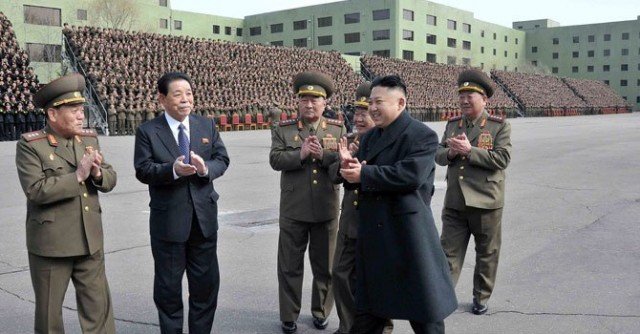
North Korea has threatened to shut down Kaesong Industrial Complex reiterating the state of war with South Korea
The industrial park funnels more than $92 million a year in wages for 53,400 North Koreans employed there, and its operation has survived despite years of military tensions. The latest threat to close down Kaesong came amid a torrent of bellicose statements by North Korea in recent days, widely seen as a strategy to increase pressure on South Korea and the US to soften their policies on the North.
Although South Korean officials reasserted that they were ready to retaliate if North Korea committed any military provocations, they said they saw no imminent sign of any such attacks.
On Saturday, cross-border traffic operated as normal, allowing hundreds of South Koreans to travel to and from Kaesong.
Over 300 South Koreans remained in the complex, where 123 South Korean textile and other labor-intensive factories employ the North Korean workers, at an average monthly wage of $144.
The fate of Kaesong is seen as a crucial test of how far North Korea is willing to take its recent threats against the South. Its continued operation was often seen as a sign that Pyongyang’s verbal militancy was not necessarily matched by its actions.
“The South Korean puppet forces are left with no face to make complaint even though we ban the South side’s personnel’s entry into the zone and close it,” North Korea said Saturday in a statement carried by its official KCNA.
North Korea said its dignity was insulted by South Korean news media reports that suggested the North kept the complex open to obtain hard currency.
In another development, some of North Korea’s main government-run Web sites were disabled on Saturday in what news media reports said were cyber attacks.
The disabled sites included those of Naenara, the government’s official Web portal; Air Koryo, the state-run airline; and Voice of Korea, Pyongyang’s international broadcast outlet.
North Korea Tech, a Web site that monitors Internet activities on the Korean Peninsula, said the problems appeared “to be part of a loosely coordinated effort by hackers to target North Korean sites.” By late Saturday afternoon, North Korean officials had not confirmed any attacks on government-run Web sites.
The problems come as some analysts suspect that cyber attacks have become an increasingly frequent weapon in the intensified sparring between the Koreas, although each side denies hacking the other.
South Korean officials suspect that North Korea was behind cyber attacks on March 20 against three banks and the country’s two largest broadcasters. The attacks came five days after North Korea blamed South Korea and the US for cyber attacks that temporarily shut down some of its official Web sites, and warned of “consequences”.
North Korea has been angry ever since South Korea and the US started a joint military exercise in early March. Its bellicosity further escalated when the UN imposed more sanctions against it after its February 12 nuclear test.
North Korea has since declared an “all-out action” against Washington and Seoul and said that the armistice that stopped the Korean War in 1953, as well as all nonaggression agreements with South Korea were nullified.
North Korean leader, Kim Jong-un, ordered all his missile units to be on standby and if provoked, attack the US and South Korea with nuclear-tipped long-range missiles, although most analysts doubt the North has them.
A statement by South Korea’s military said that although the North Korean threats were not new, they “are unacceptable and harm the peace and stability of the Korean Peninsula.”
[youtube S-W6B0fUvjs]
North Korea has declared “state of war” against South Korea in its latest escalation of rhetoric against its neighbour and the US.
A statement promised “stern physical actions” against “any provocative act”.
North Korea has threatened attacks almost daily after it was sanctioned for a third nuclear test in February.

North Korea has declared “state of war” against South Korea in its latest escalation of rhetoric against its neighbour and the US
However, few think the North would risk full-blown conflict, and the two sides have technically been at war since 1953 as no peace treaty has been signed.
An armistice at the end of the Korean War was never turned into a full treaty.
North Korea carried out its third nuclear test on February 12, which led to the imposition of fresh sanctions.
The annual US-South Korean military exercises have also taken place, angering Pyongyang further.
Many analysts believe that all-out war with South Korea and its ally the United States would be suicidal for the North, says the BBC’s Lucy Williamson in Seoul.
But with both sides threatening heavy retaliation, there’s a chance of minor incidents escalating, our correspondent adds.
A North Korean statement released on Saturday said: “From this time on, the North-South relations will be entering the state of war and all issues raised between the North and the South will be handled accordingly.
“The long-standing situation of the Korean peninsula being neither at peace nor at war is finally over.”
In Washington, Caitlin Hayden, a spokeswoman for the National Security Council, said the US had “seen reports of a new and unconstructive statement from North Korea”.
“We take these threats seriously and remain in close contact with our South Korean allies,” she said.
North Korea has made multiple threats against both the US and South Korea in recent weeks, including warning of a “pre-emptive nuclear strike” on the US and the scrapping of the Korean War armistice.
On Thursday, North Korean state media reported leader Kim Jong-un “judged the time has come to settle accounts with the US imperialists”.
Kim Jong un was said to have condemned US B-2 bomber sorties over South Korea during military exercises as a “reckless phase” that represented an “ultimatum that they will ignite a nuclear war at any cost on the Korean peninsula”.
US mainland and bases in Hawaii, Guam and South Korea were all named as potential targets.
State media in the North showed thousands of soldiers and students at a mass rally in Pyongyang supporting Kim Jong-un’s announcement
North Korea’s most advanced missiles are thought to be able to reach Alaska, but not the rest of the US mainland.
White House spokesman Josh Earnest said the rhetoric only deepened North Korea’s isolation.
China, North Korea’s biggest trading partner, has reiterated its call for all sides to ease tensions.
Foreign ministry spokesman Hong Lei told a daily news conference that “joint efforts” should be made to turn around a “tense situation”.
Russian Foreign Minister Lavrov went further, voicing concern that “we may simply let the situation slip out of our control”.
“We are concerned that… unilateral action is being taken around North Korea that is increasing military activity,” he said.
On March 16, North Korea warned of attacks against South Korea’s border islands, and advised residents to leave the islands.
In 2010, North Korea shelled South Korea’s Yeonpyeong island, causing four deaths.
[youtube MgT9o0So7C8]
North Korea announces it has put missile units on stand-by to attack US targets in response to US stealth bomber flights over the Korean peninsula.
State news agency KCNA said leader Kim Jong-un signed off on the order at a late-night meeting of top generals.
The time had come to “settle accounts” with the US, KCNA quoted him as saying, with the B-2 flights an “ultimatum”.
Pyongyang has been angered by fresh UN sanctions and annual US-South Korea military drills.
China, North Korea’s biggest trading partner, has called on all sides to ease tensions.
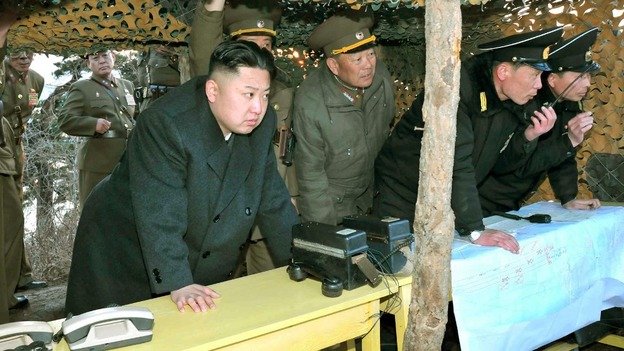
North Korea announces it has put missile units on stand-by to attack US targets in response to US stealth bomber flights over the Korean peninsula
Kim Jong-un “finally signed the plan on technical preparations of strategic rockets of the KPA, ordering them to be stand-by for fire so that they may strike any time”, the KCNA report said.
“If they make a reckless provocation with huge strategic forces, the Korean People’s Army (KPA) should mercilessly strike the US mainland, their stronghold, their military bases in the operational theatres in the Pacific, including Hawaii and Guam, and those in South Korea,” the agency quoted him as saying.
Thousands of North Koreans later took part in a march in Pyongyang in support of Kim Jong-un’s announcement, the Associated Press news agency reported.
A Yonhap news agency report citing an unidentified military official said increased activity had been noted at North Korea’s missile sites, but this remains unconfirmed.
The US – which flew two stealth bombers over the peninsula on Thursday as part of the ongoing military drills – has said it is ready for “any eventuality” on the peninsula.
In a statement, it said that the B-2 planes demonstrated America’s ability to “provide extended deterrence” to its allies and conduct “long-range, precision strikes quickly and at will”.
“The North Koreans have to understand that what they’re doing is very dangerous,” US Defence Secretary Chuck Hagel told reporters on Thursday.
“We must make clear that these provocations by the North are taken by us very seriously and we’ll respond to that.”
The US flew nuclear-capable B-52 bombers over South Korea earlier this month, in what it called a response to escalating North Korean threats.
In Beijing, Chinese Foreign Ministry spokesman Hong Lei reiterated a call for calm on all sides.
Hong Lei told a daily news briefing that “joint efforts” should be made to turn around a “tense situation”. He made similar remarks on Tuesday.
Tensions in the Korean peninsula are high following North Korea’s third nuclear test on February 12, which led to the imposition of a fresh raft of sanctions.
North Korea has made multiple threats against both the US and South Korea in recent weeks, including warning of a “pre-emptive nuclear strike” on the US and the scrapping of the Korean War armistice.
North Korea is not thought to have the technology to strike the US mainland with either a nuclear weapon or a ballistic missile, but it is capable of targeting some US military bases in Asia with its mid-range missiles.
While North Korea has issued many threats against the US and South Korea in the past, this level of sustained rhetoric is rare, observers say.
On March 16, North Korea warned of attacks against South Korea’s border islands, and advised residents to leave the islands. In 2010 it shelled South Korea’s Yeonpyeong island, causing four deaths.
On Wednesday, Pyongyang also cut a military hotline with the South – the last direct official link between the two nations.
A Red Cross hotline and another line used to communicate with the UN Command at Panmunjom have already been cut, although an inter-Korean air-traffic hotline still exists.
The jointly-run Kaesong industrial park is still in operation, however, and over 160 South Korean commuters entered North Korea yesterday to work in its factories.
Kaesong Industrial Complex employs an estimated 50,000 North Korean workers and is a source of badly-needed hard currency for the North.
[youtube wSfkZO_LRno]
Kaesong Industrial Complex at the North-South Korea border is still operating despite Pyongyang cutting a military hotline with South Korea on Wednesday.
The hotline had been used mainly to facilitate cross-border travel at the Kaesong Industrial Complex for South Korean workers.
It was the last direct official link between the two nations.
Pyongyang has been angered by US-South Korea military drills, and the fresh UN sanctions that followed its third nuclear test in February.
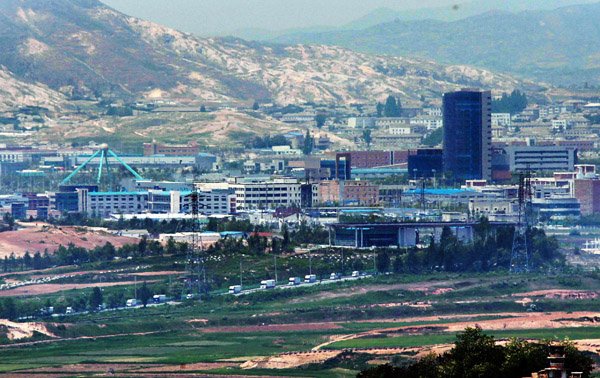
Kaesong Industrial Complex at the North-South Korea border is still operating despite Pyongyang cutting a military hotline with South Korea
In recent weeks North Korea has made multiple threats against both the US and South Korea, including warning of a “pre-emptive nuclear strike” on the US and the scrapping of the Korean War armistice.
North Korea is not thought to have the technology to strike the US mainland with either a nuclear weapon or a ballistic missile, but it is capable of targeting some US military bases in Asia with its mid-range missiles.
More than 160 South Korean commuters went through border control on Thursday morning to start work at the complex, after being approved for entry by North Korea, officials said.
North Korean authorities had used a civilian phone line to arrange the crossing, they added.
Over 500 South Koreans are scheduled to cross the border in Kaesong in Thursday.
“We say that Kaesong industrial complex will go on running, even if the war breaks out. I don’t feel so nervous,” Jang Seon-woo, a South Korean worker, told AP news agency.
The joint project in Kesong, which was established as a sign of North-South co-operation, is a source of badly-needed hard currency for the North.
Around 120 South Korean firms operate at Kaesong industrial park, employing an estimated 50,000 North Korean workers.
There have been disputes and the North Koreans have, on occasion, blocked access across the Demilitarized Zone that divides the two Koreas, who remain technically at war.
North Korea has already cut both a Red Cross hotline and another line used to communicate with the UN Command at Panmunjom in the demilitarized zone.
An inter-Korean air-traffic hotline still exists between the two sides, according to reports.
Meanwhile, in a phone call on Wednesday, US Defense Secretary Chuck Hagel told his South Korean counterpart Kim Kwan-Jin that the US would provide “unwavering” support to South Korea.
Chuck Hagel also told his South Korean counterpart that the US-South Korea alliance was “instrumental in maintaining stability on the Korean peninsula,” Pentagon spokesman George Little said in a statement.
On Tuesday, North Korea said it had ordered artillery and rocket units into “combat posture” to prepare to target US bases in Hawaii, Guam and the US mainland.
In a statement on Wednesday, North Korea’s official news agency KCNA also said that North Korea’s air force was ready to “wipe out” US military bases in Guam.
However, Guam Governor Eddie Baza Calvo described an attack as “unlikely” and urged residents not to let the threats “distract from [their] day-to-day lives”.
[youtube FwdaTCe9zmY]
North Korea has announced it severs another military hotline with South Korea.
The hotline is used to facilitate the travel of South Korean workers to a joint industrial complex in Kaesong, North Korea.
Pyongyang has been angered by fresh UN sanctions following its February 12 nuclear test and US-South Korea military drills.
In recent weeks its habitually fiery rhetoric has escalated, with multiple warnings issued.
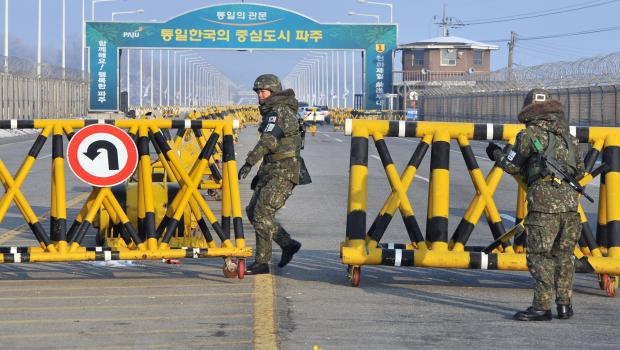
North Korea has announced it severs Kaesong military hotline with South Korea
On Tuesday, North Korea said it had ordered artillery and rocket units into “combat posture” to prepare to target US bases in Hawaii, Guam and the US mainland.
North Korea has also threatened a “pre-emptive” nuclear strike against the US in recent days and told the South it has scrapped the Korean War armistice agreement.
While the situation is currently unpredictable, some analysts believe Pyongyang may be trying to force the US and others into negotiations, with all-out war unlikely.
Pentagon spokesman George Little said on Tuesday that North Korea’s threats “followed a pattern designed to raise tensions” and that North Korea would “achieve nothing by these threats”.
North Korea has already cut both a Red Cross hotline and another used to communicate with the UN Command at Panmunjom in the Demilitarized Zone that divides the two Koreas.
The military hotline is used by the two sides to communicate over travel to the Kaesong joint industrial zone, inside North Korea.
“Under the situation where a war may break out any moment, there is no need to keep up North-South military communications,” a senior North Korean military official was quoted by KCNA news agency as telling South Korea before the line was severed.
Until now, operations at the joint complex have been normal despite the rise in tensions.
South Korea’s Ministry of Unification confirmed that North Korea was no longer answering calls to the hotline, reports Yonhap news agency.
[youtube g748T-ojqQ4]
North Korea has hit out at South Korea’s President Park Geun-hye, a day after she urged Pyongyang to change course and abandon its nuclear goals.
Warning her against “slandering”, North Korea told Park Geun-hye to behave with discretion to avoid “horrible disaster”.
Park Geun-hye’s comments came as she marked three years since the deadly sinking of a South Korean warship.
Overnight, meanwhile, South Korea briefly placed a border military unit on its highest alert.
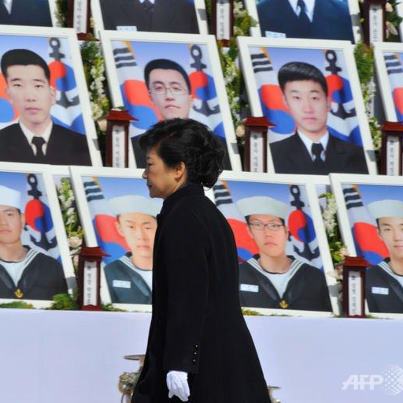
South Korea’s President Park Geun-hye spoke in Daejeon, where the 46 sailors who died when the Cheonan warship sank on 26 March 2010 are buried
The alert happened early on Wednesday after a South Korean soldier discovered a “strange object” at the border, military officials said. The alert prepares troops for a possible incursion from North Korea.
The soldier, who was at a military post in Hwacheon, in South Korea’s north-eastern Gangwon province, threw a grenade at the object at around 02:30 local time, officials said. The alert was lifted at 09:20 local time.
Tensions are high on the Korean peninsula following multiple threats from North Korea in recent days.
The border incident came hours after North Korea said it had ordered artillery and rocket units into “combat posture” to prepare to target US bases in Hawaii, Guam and the US mainland.
Pentagon spokesman George Little said that North Korea’s threats “followed a pattern designed to raise tensions” and that North Korea would “achieve nothing by these threats”.
North Korea has been angered by fresh UN sanctions imposed after its nuclear test on February 12. It also bitterly opposes joint US-South Korea military drills that are currently taking place.
In its latest statement, carried by state-run KCNA news agency, North Korea told President Park Geun-hye that its patience was being pushed to the limit.
“She should behave with discretion, clearly mindful that a wrong word may entail horrible disaster at a time when the North-South relations are being pushed to the lowest ebb and the danger of an all-out war is increasing on the Korean Peninsula,” it said.
“If she keeps to the road of confrontation like traitor [former president] Lee [Myung-bak], defying the warnings of the DPRK [North Korea], she will meet a miserable ruin.”
On Tuesday Park Geun-hye had told the North its only path to survival lay “in stopping provocations and threats, abandoning its nuclear weaponry and missiles”.
Park Geun-hye spoke in Daejeon, where the 46 sailors who died when the Cheonan warship sank on 26 March 2010 are buried. South Korea says a North Korean torpedo sank the ship; Pyongyang denies any role in the incident.
The South Korean president has spoken in the past of a desire for more dialogue with North Korea but current tensions are obstructing movements to improve ties.
Late on Tuesday, North Korean state-run media also reported that its top political bureau would soon hold a rare meeting to discuss “an important issue for victoriously advancing the Korean revolution”.
It did not specify the issue, or the date of the meeting.
[youtube gWCKyDuRLe0]
North Korea announces it has ordered artillery and rocket units into “combat posture” to prepare to target US bases in Hawaii, Guam and the US mainland.
The announcement, carried by KCNA news agency, follows days of strong rhetoric from Pyongyang.
The north Korean move came as South Korea marked the third anniversary of the sinking of the Cheonan warship, which left 46 sailors dead.
South Korea said it had detected no signs of unusual activity in the North.
Tensions remain high on the Korean peninsula in the wake of North Korea’s third nuclear test on February 12. The test led to new UN sanctions which Pyongyang strongly opposes.
Joint US-South Korea annual military drills have further angered the communist nation. In recent weeks its habitually fiery rhetoric has escalated – it has threatened the US with “pre-emptive nuclear attacks”, as well as strikes on US military bases in Japan.
“From this moment, the Supreme Command of the Korean People’s Army will be putting in combat duty posture No 1 all field artillery units including long-range artillery units and strategic rocket units that will target all enemy objects in US invasionary bases on its mainland, Hawaii and Guam,” the KCNA statement said.

North Korea announces it has ordered artillery and rocket units into “combat posture” to prepare to target US bases in Hawaii, Guam and the US mainland
North Korea is not thought to have the technology to strike the US mainland with either a nuclear weapon or a ballistic missile, but it is capable of targeting US military bases in the region with its mid-range missiles.
North Korea’s announcement comes as the country carries out large-scale military exercises, and it is not clear whether the order applies to the army as a whole or just to specific units.
In a press briefing, Chinese Foreign Ministry spokesman Hong Lei said that he hoped that “relevant parties [would] exercise restraint so as to ease the tension”.
The statement came hours after South Korean President Park Geun-hye called on North Korea to “change course” by abandoning nuclear weapons.
Speaking at the national cemetery in Daejeon where the sailors who died when the warship sank are buried, Park geun-hye said North Korea continued to threaten the South’s national security.
“For the North, the only path to survival lies in stopping provocations and threats, abandoning its nuclear weaponry and missiles, and becoming a responsible member of the international community,” she said.
The Cheonan sank in 2010 near the disputed inter-Korean western maritime border. South Korea says a North Korean torpedo sank the ship but Pyongyang denies any involvement.
Months later, North Korea shelled a border island, Yeonpyeong, in the same area, killing four South Koreans, including two civilians. It said it was responding to military exercises in the South.
Last week, South Korea and the US signed a new military plan – conceived after the shelling – pledging joint action to counter limited attacks from North Korea.
Meanwhile, websites of associations for North Korean defectors said that their networks crashed earlier on Tuesday. They said that they were victims of a cyber-attack.
Officials said that South Korean broadcaster YTN’s network and a computer network used by seven local governments were also briefly paralyzed, Yonhap news agency reported.
Daily NK, a news site focused on North Korea, said in a post on its Facebook page that it had “experienced a cyber-attack at 13:40” local time on Tuesday.
Free North Korea Radio, a radio broadcaster, also said that its website “was completely destroyed” after an attack around noon, Yonhap reported.
The presidential office, Cheong Wa Dae, said in a statement that the government was “closely working to confirm if the paralysis cases were caused by technical problems or hacking attacks”.
A cyber-attack on six South Korean banks and broadcasters last week disrupted 32,000 computers and some banking services.
The origin of the attack is not yet known, although there has been speculation that North Korea could have been to blame.
North Korea has been blamed for previous cyber-attacks on the South in 2009 and 2011.
[youtube kLd02dQueFk]
South Korea and the United States have signed a new military plan to counter what officials call North Korean “provocations”.
The plan provides for a joint response between South Korea and the US in the event of an incursion or a limited attack from North Korea, officials say.
Help from the US – which has 28,000 troops in South Korea – during minor skirmishes was previously optional.
Regional tension remains high after the North’s third nuclear test last month.
The US already offers South Korea a “nuclear umbrella”, but Cold War experts have pointed out that while nuclear deterrence may address the possibility of all-out war, it does not deter low-level incidents.

South Korea and the US have signed a new military plan to counter what officials call North Korean provocations
Under the new plan, South Korea will be able to call on US assistance should Pyongyang follow through with its recent threats, for example to attack remote South Korean islands.
“This allows both nations to jointly respond to the North’s local provocations, with the South taking the lead and the US in support,” South Korean defence ministry spokesman Kim Min-seok said on Monday.
“It will have the effect of preventing the North from daring to provoke us,” he added of the deal, which was signed on Friday.
The “provocative” acts that the plan seeks to address include incursions on the border and by low-flying aircraft, and attacks on border islands.
The new plan was conceived in 2010, after North Korea shelled a border island. A South Korean warship also sank that year, leaving 46 sailors dead. South Korea said North Korea torpedoed the ship, but Pyongyang denied this.
Last month the UN imposed fresh sanctions against North Korea following its nuclear test on February 12.
Pyongyang has responded with escalating rhetoric both to this and US-South Korea joint military drills which it bitterly opposes.
North Korea says it has scrapped the Korean War armistice and ended non-aggression pacts with Seoul.
South Korea says North Korea cannot unilaterally dissolve the armistice and has called on Pyongyang to tone down its language.
[youtube k4JstBdOsgk]
South Korean officials announce they incorrectly linked a Chinese IP address to a cyber-attack on local banks and broadcasters earlier this week.
On Thursday, the Korean Communications Commission said it had traced the attack to an internet address in China, although the identity of those behind the attack could not be confirmed.
But it said further investigation showed the malware came from a local computer in one of the affected banks.
However, South Korean officials still believe the attack was orchestrated from abroad.
Wednesday’s cyber-attack on six South Korean banks and broadcasters affected 32,000 computers and disrupted banking services.
The apparent link to China had fuelled speculation that North Korea was to blame.
Hackers can route their attacks through addresses in other countries to obscure their identities, and intelligence experts believe that North Korea routinely uses Chinese computer addresses to hide its cyber-attacks.
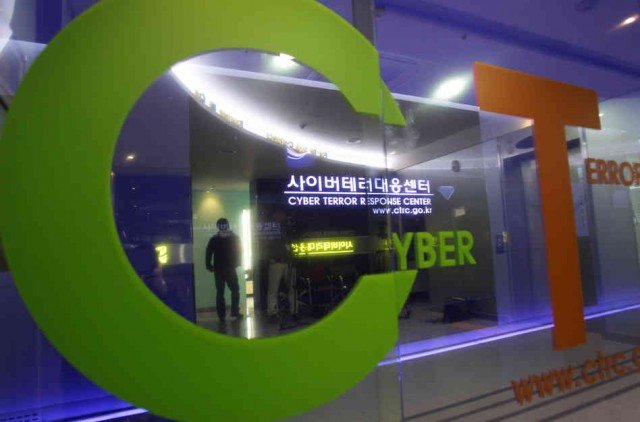
South Korean officials announce they incorrectly linked a Chinese IP address to a cyber-attack on local banks and broadcasters earlier this week
North Korea has been blamed for previous cyber-attacks on the South in 2009 and 2011.
South Korean officials initially linked the cyber-attack to an IP address in China, but on Friday said they had made a mistake.
Further investigation showed the IP address was in the internal server of Nonghyup bank, one of the victims of Wednesday’s attack.
Its IP address “coincidentally matched” a Chinese IP address, the KCC said.
“Malicious code seemed to be spread from the server [of Nonghyup Bank] and there were records of [it] being approached by someone at that time,” Lee Jae-il, vice-president of Korea’s Internet Security Agency (KISA), told reporters.
“We’re still tracking some dubious IP addresses which are suspected of being based abroad,” he said, adding that they were “keeping all kinds of possibilities open”.
South Korean officials have announced that the cyber-attack on the country’s banks and broadcasters came from an internet address in China.
However, the identity of those behind the cyber attack cannot be confirmed.
The telecoms regulator said hackers used a Chinese address to plant a malicious code that hit networks at six organizations on Wednesday.
Officials said they were continuing to investigate the origins of the attack.
North Korea has been blamed for previous attacks in 2009 and 2011.
“Unidentified hackers used a Chinese IP address to contact servers of the six affected organizations and plant the malware which attacked their computers,” said Park Jae-moon of South Korea’s communications regulator.
“At this stage, we’re still making our best efforts to trace the origin of attacks, keeping all kinds of possibilities open,” he said.
Officials stressed that the IP address did not reveal who was behind the attack, as hackers can route their attacks through addresses in other countries to obscure their identities.
However, the discovery has strengthened speculation that North Korea was behind the attack.

South Korean officials have announced that the cyber-attack on the country’s banks and broadcasters came from an internet address in China
Intelligence experts believe that North Korea routinely uses Chinese computer addresses to hide its cyber-attacks.
A taskforce is being formed to analyze the virus and stop further attacks, and free computer vaccines have been handed out to South Korean companies.
Korea’s Communications Commission (KCC) said that the attacks on all six organizations appeared to come from a single entity.
The networks had been attacked by malicious codes, rather than distributed denial-of-service (DDoS) attacks as initially suspected.
Following Wednesday’s attack, the KCC raised its cyber-attack alert levels to “caution,” the third highest out of five levels, news agency Yonhap reported.
Around 32,000 computers were affected by the incident, and some services at Shinhan bank, including internet banking and ATM machines, were disrupted.
However, so far no damage had been detected in public institutions and infrastructure, the KCC was quoted as saying by Yonhap.
The incident comes with tensions between the two Koreas high.
North Korea has stepped up rhetoric in recent days in response to fresh UN sanctions over its nuclear test in February and joint annual military drills between the US and South Korea, which it bitterly opposes.
On March 15, North Korea’s KCNA news agency also accused the US and its allies of “intensive and persistent” hacking attacks on its internet servers.
[youtube 2sT_4tj2xAM]
South Korea’s authorities are investigating a suspected cyber-attack that has paralyzed computer networks at broadcasters and banks.
Broadcasters KBS, MBC and YTN told police their networks were halted around 14:00, Yonhap news agency said.
Two banks, Shinhan Bank and Nonghyup, said their networks were affected.
The exact cause of the problems remains unknown. Last week, North Korea accused the US and its allies of attacks on its internet servers.
The networks had been “partially or entirely crippled”, the Korean Internet Security Agency (KISA), a state watchdog, said.
“This incident is pretty massive and will take a few days to collect evidence,” a police official told AFP news agency.
Staff at the three broadcasters said their computers crashed and could not be restarted, with screens simply displaying an error message, although they have continued to make television broadcasts.
There are reports of skulls popping up on some computer screens, which could indicate that hackers had installed malicious code in the networks, KISA said.
Some banking services at Shinhan bank, including internet banking and ATM machines, were also affected, although banking operations now appear to have been restored.
A third bank, Woori Bank, also came under attack but was not infected, authorities say.
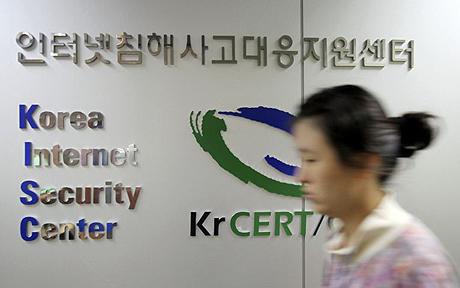
South Korea’s authorities are investigating a suspected cyber-attack that has paralyzed computer networks at broadcasters and banks
South Korean internet service provider LG Uplus said it believed its network had been hacked, Reuters news agency reported, citing an unidentified spokesman.
But AP news agency reported LG Uplus spokesman Lee Jung-hwan as saying that the company’s networks were operating normally, with no signs of a cyber-attack.
An official from the presidential office told Yonhap the authorities were “now trying to determine the cause of the network paralysis”, adding it was not yet known whether North Korea was involved.
“We do not rule out the possibility of North Korea being involved, but it’s premature to say so,” Defence Ministry spokesman Kim Min-seok said.
No government-related computer networks had been affected, an official from the National Computing and Information Agency (NCIA) told the agency.
The military has upgraded its information surveillance status by one level, Yonhap said.
North Korea is believed to have been behind two major cyber-attacks on the South in 2009 and 2011 that targeted government agencies and financial firms.
Nonghyup bank was one of the victims of the 2011 attack, which left its customers unable to access or transfer their cash for three days.
North Korea has stepped up rhetoric in recent days in response to fresh UN sanctions over its nuclear test in February and joint annual military drills between the US and South Korea, which it bitterly opposes.
Last week, North Korea’s KCNA news agency accused the US and its allies of “intensive and persistent” hacking attacks on its networks.
Official sites such as KCNA, Air Koryo and Rodong Sinmun, the party newspaper, were reportedly inaccessible for short periods.
[youtube cNbXhSPZ3TU]
The US is flying nuclear-capable B-52 bombers over South Korea, in what it says is a response to escalating North Korean rhetoric.
US officials said the B-52 flights demonstrated “extended deterrence capabilities” amid rising tension on the peninsula.
B-52, which can also carry conventional weapons, flew on March 8, with another mission set for Tuesday.
Regional tension remains high following North’s third nuclear test last month.
This is not the first time that B-52 bombers have been used as part of regular military drills between the US and South Korea.
“We’re drawing attention to the fact that we have extended deterrence capabilities that we believe are important to demonstrate in the wake of recent North Korean rhetoric,” Pentagon press secretary George Little said.
“As North Korea threatened to attack South Korea with nuclear weapons, the exercise involving B-52s is meaningful, as it shows US commitment to provide its nuclear umbrella on the Korean peninsula,” said Kim Min-seok, spokesman for South Korea’s Defence Ministry.
US Deputy Defence Secretary Ashton Carter affirmed this commitment on Monday during a visit to Seoul.
The US last week also announced plans to boost its own missile defences in the face of a growing threat from North Korea, a move over which both China and Russia have expressed concern.
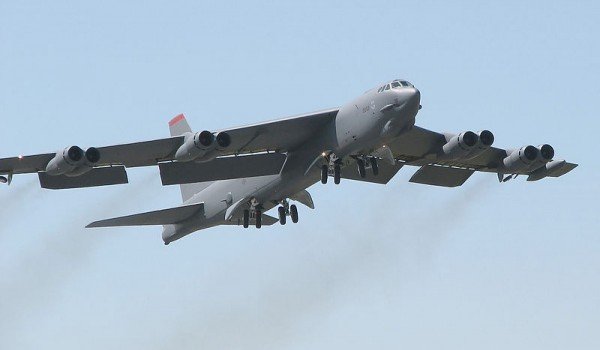
The US is flying nuclear-capable B-52 bombers over South Korea, in what it says is a response to escalating North Korean rhetoric
A spokesman for China’s Foreign Ministry said it would “intensify antagonism”, rather than improving regional stability.The UN imposed fresh sanctions against North Korea following its nuclear test on February 12.
Pyongyang has responded with strong rhetoric to this and the US-South Korea joint military drills, which it bitterly opposes.
It says it has scrapped the Korean War armistice and ended non-aggression pacts with Seoul. It has also cut off a hotline that connects the two countries.
The two Koreas remain technically at war because the 1950-53 conflict ended in an armistice, not a treaty.
South Korea says North Korea cannot unilaterally dissolve the armistice and has called on Pyongyang to tone down its language.
South Korean President Park Geun-hye on Tuesday called for North Korea to take a different approach.
“North Korea is wasting resources for nuclear development while its people are living very difficult lives,” she said.
 Prev1...8910...11Next
Prev1...8910...11Next  Page 9 of 11
Page 9 of 11

























